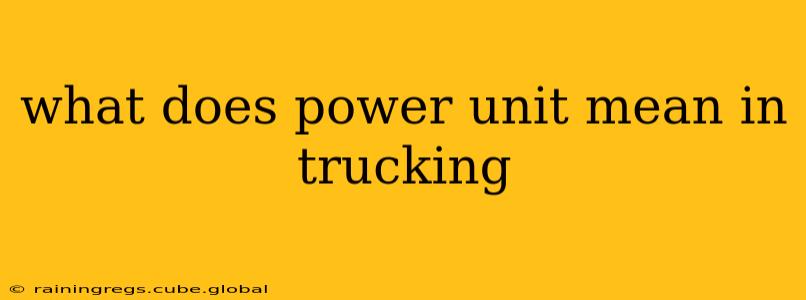In the trucking industry, the term "power unit" refers to the tractor or truck that provides the motive power for hauling a trailer or other cargo. It's the engine, transmission, and chassis that actually move the load down the road. Think of it as the "engine" of the entire trucking operation. It's distinct from the trailer, which is the unpowered part carrying the goods.
This seemingly simple definition encompasses a lot of important nuances for those in the trucking world. Let's delve into some frequently asked questions:
What's the Difference Between a Power Unit and a Tractor?
While often used interchangeably, there's a subtle distinction. A tractor is a specific type of power unit designed to pull trailers. All tractors are power units, but not all power units are tractors. For instance, a straight truck (a single unit without a separate trailer) is also a power unit, but it's not a tractor. Essentially, "power unit" is the broader, encompassing term.
What are the Key Components of a Power Unit?
A power unit consists of several critical components working in harmony:
- Engine: This is the heart of the power unit, providing the power to move the vehicle. Diesel engines are almost universally used in trucking due to their high torque and fuel efficiency.
- Transmission: The transmission manages the power from the engine to the wheels, allowing for different speeds and gears. Automatic transmissions are increasingly common, but manual transmissions are still prevalent.
- Chassis: This is the vehicle's frame, supporting the engine, cab, and other components. The chassis design impacts the power unit's weight capacity, maneuverability, and overall performance.
- Axles and Wheels: These components transfer the power from the transmission to the road, allowing the truck to move forward. The number of axles and their configuration influence the truck's weight capacity and stability.
- Cab: This is where the driver sits and controls the vehicle. Cab features vary significantly, with comfort and technology playing major roles.
What are Some Common Types of Power Units?
The trucking industry uses a variety of power units, each suited to different tasks:
- Class 8 Tractors: These are heavy-duty tractors designed for long-haul transportation and often pulling large trailers.
- Straight Trucks: These are single-unit trucks without a separate trailer, ideal for shorter-distance deliveries and smaller loads.
- Day Cabs: Tractors with smaller, more basic cabs designed for shorter trips and regional hauling.
- Sleeper Cabs: Tractors with larger cabs that include sleeping berths, allowing drivers to rest during long trips.
How is the Power Unit's Performance Measured?
Several factors determine a power unit's performance:
- Horsepower (hp): This measures the power output of the engine.
- Torque: This measures the engine's rotational force, crucial for pulling heavy loads.
- Fuel Efficiency: This is crucial for cost-effectiveness, measured in miles per gallon (mpg).
- Payload Capacity: This refers to the maximum weight the power unit can safely haul.
Understanding the power unit is fundamental to grasping the intricacies of the trucking industry. It’s the workhorse of the operation, responsible for efficiently and safely moving goods across vast distances. The specifics of a power unit's components and performance greatly impact its suitability for various trucking applications.
